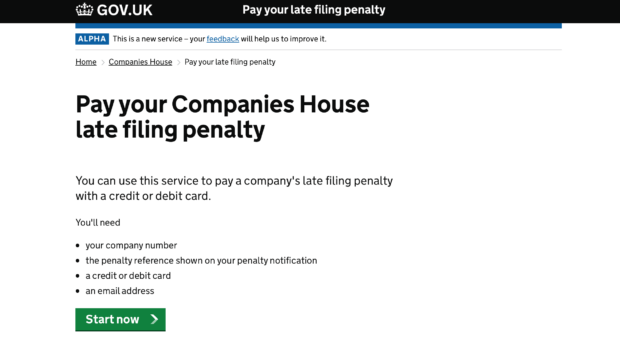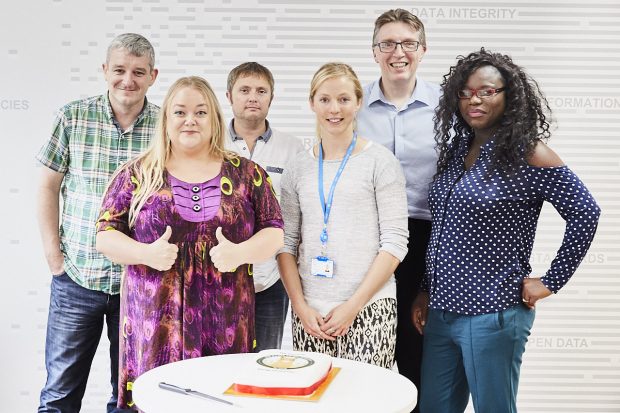My name is Amy Harcombe and I’m lead product manager at Companies House. I work on delivering digital services to our users. For the last few months a small team of us have been working on a new service for companies to pay their late filing penalties online.
At the moment people can only pay their late filing penalties by phone or sending a cheque. We wanted to build something to let them easily pay online.
We’d much rather companies file their accounts on time to keep the public register as up-to-date as it can be. But as we issue around 180,000 late filing penalties each year, we want to make the payment process as easy as possible.
After a short discovery phase to find out about our users and what their needs were, we built prototypes of various journeys which we thoroughly tested with users to find out if they met their needs. Unsurprisingly, our users told us that the process should be as quick and easy as possible, and that they’d much rather pay by credit or debit card online. We’ve also been working with Government Digital Service (GDS) and our third party finance system supplier to work out the best way to build the service, and we’ll be using GOV.UK Pay, as a quick and easy way to make payments online.

At this stage we were really happy with how the project had progressed. We were working well as a team identifying what our user needs were and creating a service based on them. As well as collaborating across different departments and with external stakeholders, we had carried out extensive testing with more than 40 users.
So it was time to take it to an alpha service standard assessment, to make sure the service is ready to progress to its next ‘beta’ stage of development, where it will be tested further with real users to meet the standards needed for public government services. At Companies House, we’ve been working this way for a while and are familiar with the different phases of:
- discovery
- alpha
- beta
- live
- retirement
But for anyone new to agile delivery and wants to know more about the different phases and how to meet the cross government digital service standard – the GDS service manual is a great place to start.
Our assessment was booked in at Government Digital Service (GDS) offices in London, and on the day our assessment team consisted of myself as service manager, Phil Martin (user researcher), Ollie Williams (interaction designer) and Mark Fairhurst (technical architect). Mark Hulett also came along from the user research team as an observer, but contributed throughout the day as well.

When we arrived, our GDS digital engagement manager, James, helped us set up the assessment room, where we added some of our work to the walls as reference material; such as user personas, example letters, usability methods, etc.
The assessment started with the team giving some background to Companies House, what we do, what documents companies need to file, and the late filing penalty process, before talking specifically about this new service. I then ran through a demonstration of the prototype, explaining where it’s come from and what it looks like now. We had an excellent story on how we’ve iterated the designs based on user feedback and how the final alpha prototype looks different to the first journey.
After the demonstration, it was straight into a conversation about our users of the service, what we did in the discovery phase and what the user needs are. As expected for an alpha assessment this took up a fair proportion of the time; but we later moved on to how the team works, the design, the technical architecture and the performance and analytics of the service. Basically, the service assessment covers all 18 points of the Digital Service Standard to make sure the service is good enough for public use.
Throughout the whole assessment, we only had a quick 5 minute break, so we powered through and managed to finish in just over 3 hours, which is actually quite short in assessment terms. We left the building feeling that we’d given a good account of ourselves, along with a mixture of exhaustion and relief.
Overall it was a very positive experience. The style of the assessment was very relaxed and conversational. The assessors raised some interesting points and gave helpful tips, which will be useful for us going into the beta phase.
In true agile form, we also took part in a ‘retro’ of the experience, as the service assessment team are keen to continually learn and improve based on the feedback.
We had a 3 day wait for the result. We were delighted to hear we’d met the service standard overall with our effective agile working and structured approach to identifying and segmenting user needs. We were thrilled to be praised as 'exemplary' for working together with our finance colleagues to improve the content and language presented to users, as this was something we’d worked really hard on.
The team and I celebrated with a cake containing our team mission ‘patch’ (designed by Ollie) and we’re finishing up with matching stickers to mark the achievement. Yes, it’s a llama. There’s no meaning behind the llama. We just like llamas.

It does not end there, though, this is just the beginning. We’ll move into a beta phase, where we’ll build on the work we’ve done so far and continue to test what we build with a range of users, before launching a fully end-to-end service into a private beta with selected users.
Then, when we’re ready, we’ll book in a beta service assessment to verify the service is fit to launch as a public beta for everyone to use. Meeting the service standard at beta assessment will mean our service is ready to be launched on GOV.UK and anyone who needs it can use it. All of our effort identifying user needs, testing prototypes, changing features, working with industry and across government to identify and meet diverse needs of users will result in a service that is easy to use for all.
The service will be very simple to start with, just allowing users to pay their penalties using a credit/debit card online. But we have plans to introduce other payment methods and integration into our other services, making it even easier for companies to maintain their company record.
To keep in touch, sign up to email updates from this blog, or follow us on Twitter.
